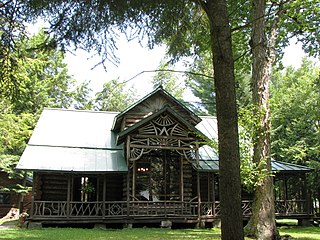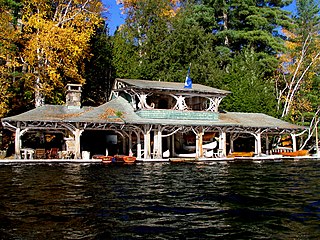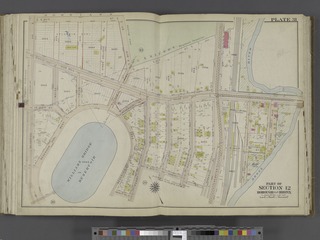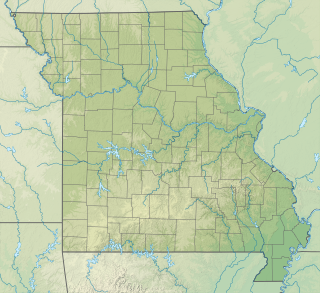
Keene is a town in central Essex County, New York, United States. It includes the hamlets of Keene, Keene Valley, and St. Huberts, with a total population of 1,144 as of the 2020 census

Saranac Lake is a village in the state of New York, United States. As of the 2010 census, the population was 5,406. The village is named after Upper, Middle and Lower Saranac lakes, which are nearby.

The Adirondack Park is a part of New York's Forest Preserve in northeastern New York, United States. The park was established in 1892 for “the free use of all the people for their health and pleasure”, and for watershed protection. The park's boundary roughly corresponds with the Adirondack Mountains. Unlike most state parks, about 52 percent of the land is privately-owned inholdings. State lands within the park are known as Forest Preserve. Land use on public and private lands in the park is regulated by the Adirondack Park Agency. This area contains 102 towns and villages, as well as numerous farms, businesses and an active timber-harvesting industry. The year-round population is 132,000, with 200,000 seasonal residents. The inclusion of human communities makes the park one of the great experiments in conservation in the industrialized world. The Forest Preserve was designated a National Historic Landmark in 1963.

Prince William Forest Park was established as Chopawamsic Recreational Demonstration Area in 1936. Its location is in Triangle, Virginia, adjacent to the Marine Corps Base Quantico. The park is the largest protected natural area in the Washington, D.C. metropolitan region at over 16,000 acres (6,500 ha). Today, the park is a window into the past and serves as an example of what much of the East Coast once looked like centuries ago.

Thendara is a hamlet and census-designated place (CDP) in Herkimer County, New York, United States. Thendara is located in the Adirondack Park, in the southern part of the town of Webb, west of Old Forge on Route 28.

Camp Pine Knot, also known as Huntington Memorial Camp, on Raquette Lake in the Adirondack Mountains of New York State, was built by William West Durant. Begun in 1877, it was the first of the "Adirondack Great Camps" and epitomizes the "Great Camp" architectural style. Elements of that style include log and native stonework construction, decorative rustic items of branches and twigs, and layout as a compound of separated structures. It is located on the southwest tip of Long Point, a two-mile long point extending into Raquette Lake, in the Town of Long Lake in Hamilton County, New York.

Camp Topridge is an Adirondack Park Great Camp bought in 1920 and substantially expanded and renovated in 1923 by Marjorie Merriweather Post, founder of General Foods and the daughter of C. W. Post. The "camp", near Keese Mill, in the U.S. state of New York, was considered by Post to be a "rustic retreat"; it consisted of 68 buildings, including a fully staffed main lodge and private guest cabins, each staffed with its own butler. It was one of the largest of the Adirondack great camps and possibly the most elaborately furnished.

Williamsbridge Reservoir was a natural lake measuring 13.1 acres (5.3 ha) just south of Van Cortlandt Park in the Bronx, New York. Specifically the body of water was located at 208th Street and Bainbridge Avenue. It was shaped like a saucer and was normally 41 feet (12 m) deep. Its water level dropped approximately 14 feet (4.3 m) in mid-August 1901. On April 3, 1934 Commissioner of Water Supply, Gas and Electricity, Maurice P. Davidson, proposed that it be offered to Robert Moses to be used as a park site. The reservoir had ceased to be used after 1919.

Roaring River State Park is a public recreation area covering of 4,294 acres (1,738 ha) eight miles (13 km) south of Cassville in Barry County, Missouri. The state park offers trout fishing on the Roaring River, hiking on seven different trails, and the seasonally open Ozark Chinquapin Nature Center.

The Arab Mountain Fire Observation Station is a historic fire observation station located on Mount Arab at Piercefield in St. Lawrence County, New York. The station includes a 40-foot-tall (12 m), steel frame lookout tower erected in 1918, an observers cabin built about 1948, a trace of the foundation of the original cabin, a structure probably used as a root cellar in the 1940s, and the foot trail. The tower is a prefabricated structure built by the Aermotor Corporation and provided a front line of defense in preserving the Adirondack Forest Preserve from the hazards of forest fires.

The Balsam Lake Mountain Fire Observation Station is located at the summit of the mountain of that name in the Town of Hardenburgh, New York, United States. It comprises a steel frame fire lookout tower, the observer's cabin and privy and the jeep road to the complex.

The Pillsbury Mountain Forest Fire Observation Station is a historic fire observation station located on Pillsbury Mountain summit at Arietta in Hamilton County, New York. The tower was built in 1924 by the Aermotor Windmill Company and the associated observer's cabin and shed in 1950. The lookout tower measures 69 feet tall.

L. C. Simonds Adirondack Cabin, also known as "Breezy Bluff Cottage," is a historic home located near Clemons, Washington County, New York. It was built in 1910 and is a rustic Adirondack-style dwelling.

Debar Pond Lodge is a historic Great Camp and national historic district located within the Adirondack Forest Preserve at Duane in Franklin County, New York. The camp was designed by William G. Distin and built about 1940. The main lodge is a rambling two-story, Rustic style building of light-frame construction with an exterior veneer of half and full round logs. The interior features a centrally located, two-story Great Room. Also on the property are the contributing boathouse; a guide house/garage; a generator house; a barn; a shed; a greenhouse and potting shed; and stone posts which mark the associated stone-lined walkway to the lodge's principal entrance. The property was privately owned until 2004, and is now a part of the Adirondack Forest Preserve and under the management and control of the New York State Department of Environmental Conservation.

Northbrook Lodge on Osgood Pond is a historic camp located within the Adirondack Forest Preserve in Paul Smiths in Franklin County, New York. The camp complex was built by noted great camp builder Benjamin A. Muncil for Canadian Senator Wilfrid Laurier McDougald Construction took circa 1925. Contributing resources in the camp complex include a small stone electrical building; covered canoe slips; pumphouse; stone bridge ; guideboat house; tennis cottage and court; dining room; kitchen; breezeway; library; shuffleboard court; Marcy cabin; boathouse; Gabriels cabin; Main cabin; Whiteface cabin; and Fairfield / staff house. The buildings exhibit American Craftsman style architectural influences. Northbrook Lodge was operate as a summer resort until 2009 and is now privately owned.

Werrenrath Camp is a historic Great Camp located in Dannemora in Clinton County, New York. It was built in 1928 for opera singer Reinald Werrenrath (1883–1953) as a summer estate. The property includes the main house, a boathouse, an ice house, and two stone gate posts. The main house is a two-story, rectangular, limestone sheathed dwelling measuring approximately 37 feet wide and 61 feet long. The interior has Shingle Style, Tudor Revival, and Arts and Crafts style design elements.

Big Moose Community Chapel is a historic chapel located on Big Moose Lake near Eagle Bay in Herkimer County, New York. The chapel was built in 1931, and is a modified "L"-plan Late Gothic Revival style church constructed of locally quarried granite. It has a cross-gable roof and features a small square belfry and pointed arch openings. It was built by master builder Earl Covey and incorporates Adirondack style architectural elements.

Woodward Hall, also known as the Stone House, Earl Woodard House, and "Woodhill," is a historic home located in the town of Lake Luzerne in Warren County, New York. It was built in 1931–1932, and is a two-story, rectangular building, five bays wide and two bays deep, with Tudor Revival and Colonial Revival style design elements in a somewhat eclectic design. It has fieldstone walls and a cross-gable slate roof and sits on a poured concrete foundation. It has a small, two-bay garage attached to the main block. It was built for Earl Woodward (1891-1956), who reinvented Adirondack tourism in the Lake George region through the introduction of dude ranch style resorts during the 1920s.

People's African Methodist Episcopal Zion Church is a historic African Methodist Episcopal Zion church located in Downtown Syracuse, Onondaga County, New York. It was designed by architect Charles Erastus Colton and Wallace Rayfield and built in 1911. It is a small Gothic Revival style stuccoed brick building. It sits on a cut limestone foundation and measures approximately 25 feet wide and 50 feet deep. It has a two-story projecting front gable and features a three-story bell tower topped by a pyramidal roof. The congregation was incorporated in 1837 and remained at this location until 1976.

Putnam Camp is a historic former farm and Adirondack seasonal camp and national historic district located at St. Huberts, Essex County, New York. The district encompasses 11 contributing buildings and 1 contributing structure in the Lower Camp and Upper Camp relating to the property's historic uses as a farm and later a camp. It was developed in the mid-19th century as the Beede farm and the property includes the Beede farmhouse and timber frame barn / woodshop. Later farm-related buildings include the Bungalow. The camp was established in 1875–1876 and subsequently cabins were built including the Coop, Chatterbox, Stoop, Shanty, Nursery and Parent's Assistant, Ark (1905), and the Doctor's House. The property was developed in the mid-1870s by three prominent Boston families - Bowditch, Putnam, and James, namely Henry Pickering Bowditch (1840–1911), William James (1842–1910), Charles Pickering Putnam (1844–1914), and James Jackson Putnam (1846–1918).



















